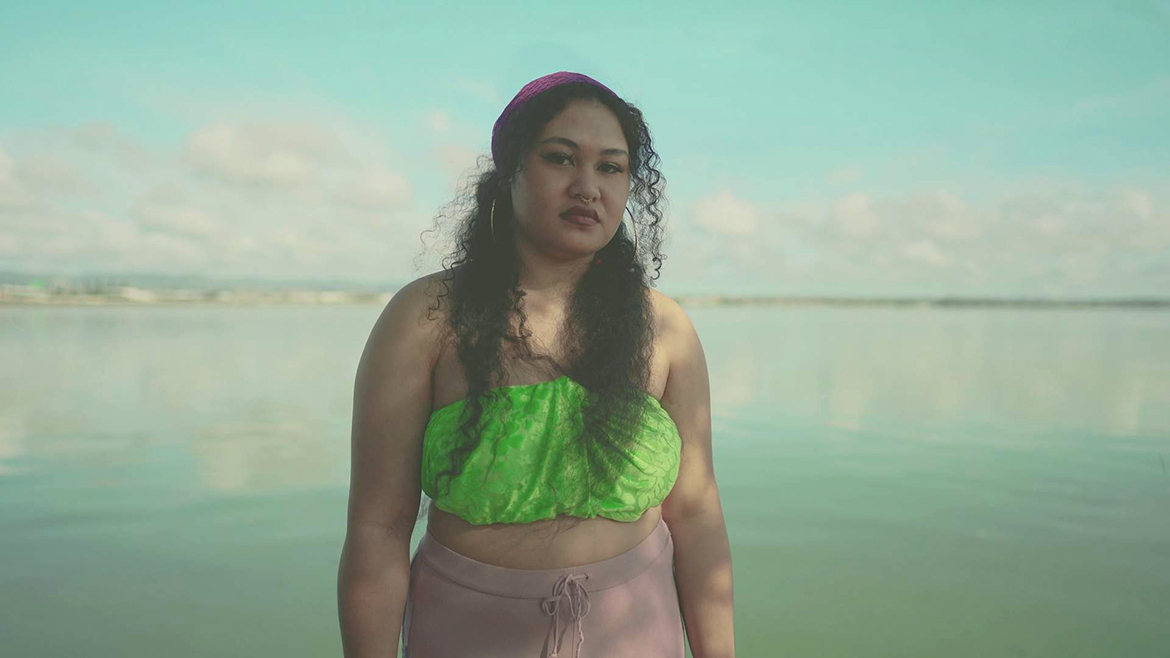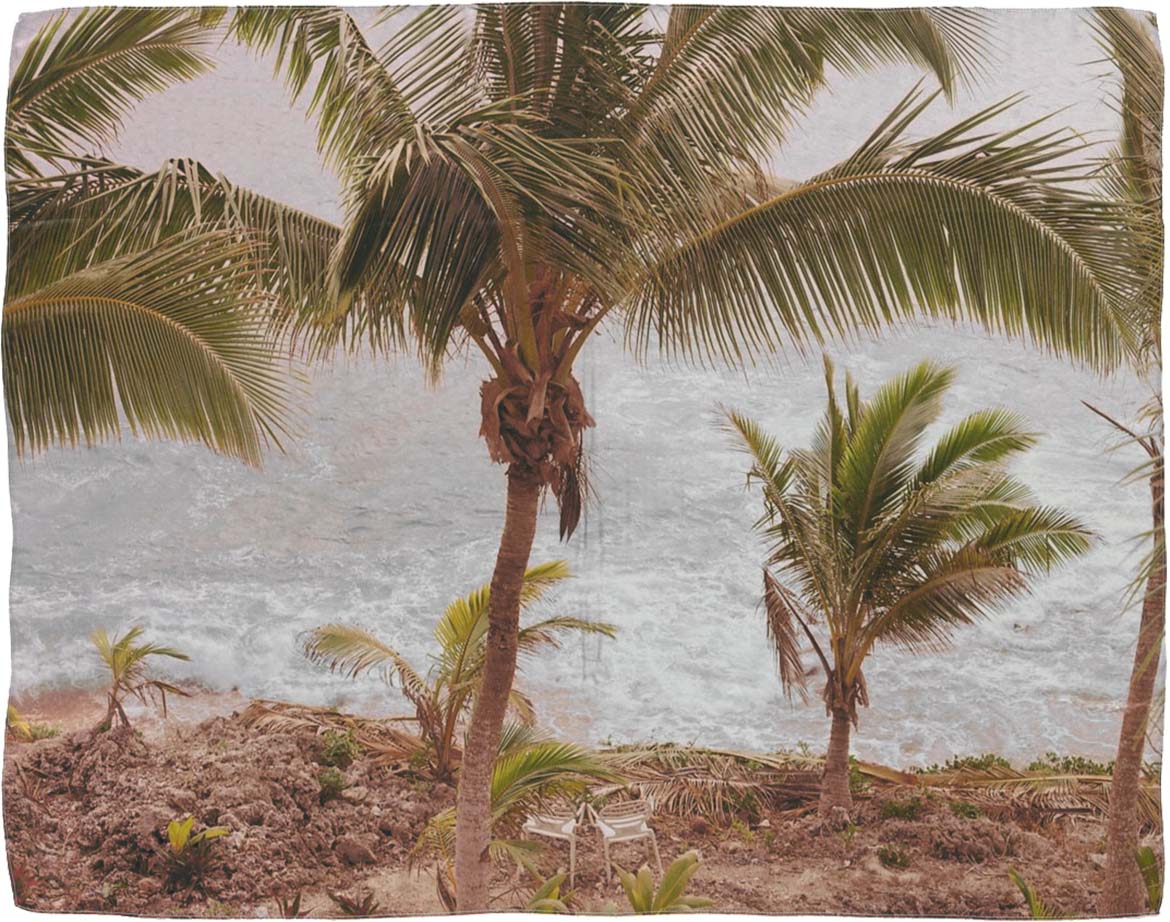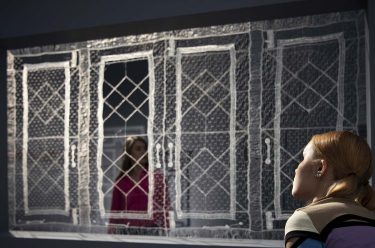Edith Amituanai’s captivating ‘L’a’u Pele Moana (My darling Moana)’ 2021 (Illustrated) was one of the first artworks to be installed as part of ‘The 10th Asia Pacific Triennial of Contemporary Art’ (APT10). Its imprint on me was immediate. Waves of sentimentality washed over me as I indulged in the slices of life captured by Edith on the gallery walls. Care-free brown skinned kids. Palm trees swaying in the breeze. Rich reverberating harmonies. The city that birthed me. The familiar blue of our ocean. My darling ocean. I didn’t have to read the didactic to feel the sense of longing for what was left behind. Long after leaving Edith’s poignant oeuvre, these familial elements left a lasting impression on me as a South Auckland born, Brisbane raised, Sāmoan woman.
Edith Amituanai ‘L’a’u Pele Moana (My darling Moana)’ 2021

I had the honour of recounting this experience to Edith herself who confirmed that I was exactly the target audience she had in mind when creating the work. ‘I thought about you and all of the people that have crossed the ocean in pursuit of new opportunities. It was like sending you a postcard. We can’t see you but we’re thinking of you,’ she said to me over Zoom from her home in Aotearoa. Edith’s obsession with the way people are shaped by their environment invites us to ponder, ‘how does the land you grew up on, the kind of grass or dirt that carried you — how does it shape your values, your culture, or even the very essence of what makes you, you?
Edith Amituanai ‘View from Matavai resort, Niue’ 2022

Edith Amituanai ‘The Quarry (from ‘L’a’u Pele Moana’ 2022

After moving from Aotearoa to Australia, I pivoted between being too brown for the white people and being too white for the brown people. Long before discovering the word ‘diaspora’, I spent many a day wrestling with the tension of finding home away from home and searching for a sense of belonging in a foreign place. I sought out any and every opportunity to validate my cultural ties to Sāmoa through dance, song, dress, food, art and community. While these cultural expressions no longer define me in and of themselves, their influence was significant in my geographical transition and served as conduits connecting me back home.
Learning that these sentiments were shared by many others, as highlighted during the Pasifika Young Peoples Wellbeing Network activation for the ACE Project, was reassuring to me for many reasons. Edith’s work became a catalyst for rich conversations as fellow members of the Pasifika diaspora explored how her use of powerful imagery connected them to their heritage, prompting reflections on the intergenerational journey of Pasifika people over time. The paradoxical notion of the moana evoking sentiments of both longing and aspiration moved them to dream of future possibilities for our people, as descendants of fearless voyagers.
Growing up in Australia, the land of milk and honey was not wasted on me. But what is milk and honey if my soul remains malnourished? Western ideals of milk and honey focus on health, wealth and prosperity, often accompanied with a dollar sign. Pasifika ideals of milk and honey are associated with and are found in connection to community. The collective. The village. Aiga. The benefits of living in the ‘land of milk and honey’ are undeniable from the perspective of accumulative wealth and status. But do these elements provide such sustenance for the soul, in the way milk and honey was revered and coveted in the times of Moses? I explore the concept of what truly nourishes us and offer my story as a postcard sent to those who left and those who stayed behind.
three years young
left the long white cloud
for golden sunburnt plains
knees grazed by afternoons spent
bike riding on gravel roads well-travelled
by the tamaiti of tāmaki makaurau
arms adorned with temporary tattoos
thanks to bubblegum snuck in during dairy trips for frujus
sour faced at auckland airport
in the brown puletasi nana made just for me
fluent in sāmoan and being a bots
with all that practice
I’ve only retained fluency in one
and it’s not on the didactic
uprooted
to grow on land not my own
but how can I
an ocean away from my abode
when the resources to nourish are out of reach
the milk and honey
are a different brand
the niu tastes like plastic
less sweetness less fatness
back in grandma’s day
you’re warm regardless of what the weatherman says
here they burn
stuck in a perpetual state of other
my mother tongue twisted
name became unpronounceable
lunchbox unpalatable
flavour must be foreign here
I take my lemons and make raro
teach myself to dance
through the in between
teach them how
to say my name
include all the apostrophes
navigating new spaces
I seek out brown faces
different versions of me
sweet harmonies in threes
the hums of a nylon string
hyena laughs, slapping arms and jokes that sting
touchstones tethering myself to home
embracing the warmth
pohutukawa trees turned to eucalyptus leaves
coconut oil to mozzie coils
thick mink floral blankets
kookaburra wake up calls
I bask in the sunshine whilst longing for the sails
pining in the midst of plenty
the graveside cul de sac
esoteric nicknames
revolving door house
more mattresses than floor
repositories of used to be’s
counting down the days
I can lay the bouquet of flowers picked while away
adopted lands made me who I am
grown but still growing
a daughter of the moana
she separates and connects us
when I go beyond the reef
in the name of opportunity
I bring my village with me
e lele le toloa i fea ae ma’au lava i le vai
no matter where the bird flies
it will always return to the water
its home
At the start of 2022, I moved out of home again to a new city in the name of opportunity, this time on my own. I think of my forebears who traversed uncharted waters with no map to guide them. All they had was where they came from and an assured confidence in who they were. I think I owe it to them to build upon their boldness, on their sacrifice, to strive to go further. I’ve learned that the further forward we advance, the more grounded we need to be, and as the unfamiliar becomes the familiar, we become the ancestors on which our descendants will build their scaffolds as they reach further and higher than we could ever have dreamed. Returning home does not always require a flight; sometimes it’s a conversation, a meal, a song, or maybe even an afternoon spent at the gallery. Where milk and honey is not easily accessible, we can fashion the tools to collect and mould them in our own way. Just like our ancestors did.
Osanna Fa’ata’ape is a South Auckland–born Samoan woman, whose lineage stretches to the villages of Sale’aula, Vaie’e and Iva. Fa’ata’ape was raised in Meanjin (Brisbane), Queensland, and is now based on Ngunnawal Country, Australian Capital Territory.
This is the third in a series of blogs on the ACAPA Community Engagement Project.
The Australian Centre of Asia Pacific Art (ACAPA) is the Queensland Art Gallery | Gallery of Modern Art’s Asian and Pacific research and publishing arm.
‘The 10th Asia Pacific Triennial of Contemporary Art’ (APT10) / Queensland Art Gallery (QAG) and Gallery of Modern Art (GOMA) / 4 December 2021 to 25 April 2022.
The ACE Project, coordinated by Ruha Fifita (Curatorial Assistant, Pacific Art, QAGOMA), invited members of the Queensland Pasifika community to contribute to activations and projects within APT10. This project is supported by the Australian Government through the Office for the Arts.
#QAGOMA


